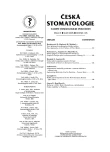Computing Control of the Shape of Dental Arch in Patients with Cleft Palate
Authors:
R. Hippmann 1; T. Dostálová 1; M. Bartoňová 1; M. Peterka 2,3; K. Morong 4; V. Smutný 4
Authors‘ workplace:
Stomatologická klinika 1. LF UK a VFN, Praha
přednosta prof. MUDr. J. Mazánek, DrSc.
1; Ústav experimentální medicíny AV ČR, Praha
2; Klinika plastické chirurgie FNKV, Praha
přednosta doc. MUDr. M. Tvrdek
3; Centrum strojového vnímání, katedra kybernetiky FE ČVUT, Praha
vedoucí katedry prof. ing. V. Hlaváč, CSc.
4
Published in:
Česká stomatologie / Praktické zubní lékařství, ročník 105, 2005, 5, s. 100-107
Category:
Overview
The aim of the work was to evaluate the shape and dimension of upper and lower arch in patients with cleft palate after a surgical-orthodontic therapy. We also compared these results with values measured in a randomly selected sample of a young adult population and patients with orthodontic anomaly without cleft palate before the treatment, immediately after therapy and after a lapse of time of 5 years. The measurement employed the Orthoscope apparatus and computing analysis of the image. It has been demonstrated that in patients with orthodontic anomalies and orofacial cleft palate, modern orthodontic therapy is capable of enlarging the upper dental arch to values, which are considered as standard and to create optimal conditions for subsequent prosthetic therapy, if necessary.
Key words:
stomatology – orthodontia – prosthetics – cleft palate
Labels
Maxillofacial surgery Orthodontics Dental medicineArticle was published in
Czech Dental Journal

2005 Issue 5
Most read in this issue
- Diagnostic Possibilities in Impacted Teeth with Horizontal Position Near to Middle Palate Suture
- New Approaches to the Problem of Third Molar
- Augmenting Materials Used in Dentistry – Present State
- Gingival Changes after Immunosuppressive Therapy II.
